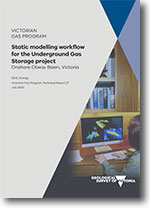VGP Technical Report 27 - Static modelling workflow for the underground gas storage project, Onshore Otway Basin, Victoria.
 |
| |||||||||||||||||||||||||||||||||||||||||||||||||||||||||||||||||||||||||||||||||||||||||||||||||||
Product description:About the Victorian Gas Program: The Victorian Gas Program (VGP) is a comprehensive science-led program, incorporating geoscientific and environmental research to assess the risks, benefits and impacts of potential onshore conventional gas exploration and production. The program is also investigating the potential for further discoveries of onshore conventional and offshore gas in the Otway and Gippsland geological basins and assessing the feasibility of additional onshore underground gas storage in depleted reservoirs around the Port Campbell area. The VGP includes an extensive, proactive and phased community and stakeholder engagement program, through which the results of the scientific studies are being communicated. Executive summary: The opportunity for further underground gas storage (UGS) in depleted gas fields in the onshore Otway Basin is being investigated as part of the Victorian Gas Program (VGP). There are currently three depleted gas fields used for UGS in Victoria. These sites are in the Port Campbell area in the onshore Otway Basin. The Geological Survey of Victoria (GSV) engaged SEAL Energy Pty Ltd (SEAL Energy) to carry out a suite of technical studies to investigate the potential for further underground gas storage at existing depleted gas fields in the onshore Otway Basin. Six sites (depleted gas fields) were selected through a ranking process (Bagheri, 2019) for static and dynamic modelling. The sites are Croft, Fenton Creek, McIntee, Mylor, Penryn and Tregony. Prior to the dynamic modelling, a static geological model of each depleted gas field was built. This report presents the static modelling workflow that was undertaken for the static modelling in detail and provides background on the methodology. This report is supplementary to the overview provided in each modelling report. Publicly available data was compiled, analysed and reviewed for each of the six sites. A depositional model was developed for each field to predict facies trends for input into the property model. Then a structural model was built, honouring well and seismic interpretation. Three structural surfaces were used to model the area of interest: the top of the Belfast Mudstone, top of the Waarre Formation and top of the Eumeralla Formation. These represent the top of the seal, and the top and base of the reservoir, respectively. Zone modelling was then performed to capture the structural features between these surfaces, including the Flaxman Formation and Waarre Formation units B and A. Lastly, the model was populated with reservoir properties including porosity, permeability and water saturation following two different methods to provide the dynamic simulators with a suite of static models to carry out fluid flow simulations. The resultant static models allow for volumetric calculations to quantify gross rock volume, pore volume and original gas in place. The final static models honour well and seismic structural data, the interpreted lithologies, porosities and permeabilities derived from the well cores and well logs for use in numerical simulations (subsequent dynamic modelling) to characterise the depleted gas fields and understand their underground gas storage potential. Specific volumetric calculations for each field are reported in each of the six static modelling reports. Each static model technical report is accompanied by the static model for each depleted gas field. Bibliographic reference: SEAL ENERGY, 2020. Static modelling workflow for the Underground Gas Storage project, Onshore Otway Basin, Victoria. Victorian Gas Program Technical Report 27. Geological Survey of Victoria. Download: The downloadable version of this report is supplied in PDF format (26.9 MB). Related products:
| ||||||||||||||||||||||||||||||||||||||||||||||||||||||||||||||||||||||||||||||||||||||||||||||||||||








